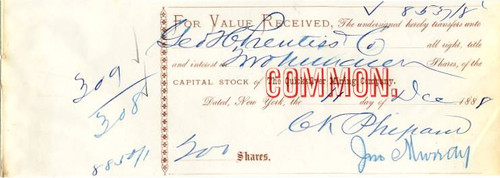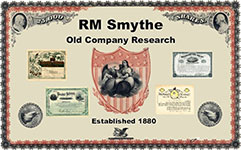Printed stock transfer certificate from the Quicksilver Mining Company issued in 1888. This item is hand signed and is over 116 years old. The company was incorporated in the State of New York. A History of Mexican Americans in California: HISTORIC SITES -------------------------------------------------------------------------------- Spanishtown Site New Almaden, Santa Clara County Spanishtown, with its homes, school, church, and cantina, where Mexicanos, Californios, and Chileno miners lived and worked, no longer exists. The 5.6-acre site in Santa Clara County is now covered with meadow grass and bushes. The area where Spanishtown and Englishtown were located is closed to the public. The only remnants of Spanishtown are a picket fence surrounding one of the overgrown cemeteries and a number of large cacti planted by miners near their homes. The New Almaden Quicksilver Mine, the oldest and most productive quicksilver mine in the United States, was discovered by Mexicanos. Moreover, it was initially developed by Mexicanos using Spanish/Mexican mining technology, and worked with Mexican labor until the turn of the century. The importance of Mexicanos to California's first capital-intensive mining venture merits public recognition. In 1824, Secundino Robles, a native Californio, was the first non-Indian person to discover the cinnabar deposits, the "mahetka" or vermillion-colored rocks that the Ohlones used for adornment. These deposits are located in the Capitancillo Hills 12 miles from San Jose on land once owned by Jose Reyes Berryessa, a retired sergeant of the Presidio of San Francisco. When Robles told Antonio Sunol and Luis Chabolla about his discovery, they thought they might find gold or silver in the unusual, vermillion-colored, cinnabar deposits high on the hills above Los Alamos Creek. Finding neither gold or silver, Sunol and Chabolla abandoned their venture. In 1845, Andres Castillero, a native of Spain and a captain in the Mexican military, visited Alta California and became interested in the red rock he saw at the Mission Santa Clara. Castillero was trained in geology, chemistry, and metallurgy. He was also familiar with the quicksilver mines of La Mancha, Spain. Castillero experimented with the red rock. He fired and roasted samples of it, and concluded the roasted rock was cinnabar, the bearer of mercury. On November 22, 1845, Castillero filed the required declaration of intent with Pedro Chabolla, the Alcalde of the pueblo of San Jose. Castillero named the mine the Santa Clara, and divided ownership into 24 shares: four shares to Father Jose Maria de Real, four to Don Juan Castro, four to Secundino and Teodoro Robles, and 12 for himself. On December 3, 1845, Castillero expanded his declaration to the effect that in conjunction with the claim of silver with a ley of gold, he had definitely discovered quicksilver. He provided sufficient evidence to support his claim. On December 30, 1845, First Alcalde Antonio Maria Pico awarded a certificate of possession to Castillero for 3,000 varas (yards) of land in all directions. Castillero returned to the mine with William Chard, a carpenter he had met in San Jose, and hired Indian workers to build rudimentary furnaces to work the mine. By August 1846, approximately 3,000 pounds of ore had been fired with favorable results at the Santa Clara. Realizing, however, that he needed capital, labor, and equipment to develop his mine, Castillero left for Mexico to try to secure the means to develop his venture. He never returned to California. Castillero's services were required by the Mexican military in the mounting conflict between Mexico and the United States. Late in 1846, Castillero and Juan Castro sold their shares in the Santa Clara to the Barron, Forbes Company, an English industrial firm that operated a cotton mill in Tepic, Mexico. The Barron, Forbes Company changed the Santa Clara's name to the New Almaden, after the famous Almaden quicksilver mine in Spain, which had been operating for centuries. The term Almaden, derived from Arabic, means "the mine." In the fall of 1847, Alexander Forbes arrived from Mexico with a large crew of workers and equipment, and with John Young, who would superintend the operation. The Barron, Forbes Company initiated the first organized mining operation in the Mexican territory of California. Mexican labor built the major structures at the New Almaden. The "Hacienda de Beneficio," or "reduction works," was built at the gateway to the mine on the banks of Los Alamitos Creek. That structure still stands. Next, workers built small houses over several low ridges in a large, open ravine. The ravine area, known as Deep Gulch, became the location of the Spanishtown settlement, which accommodated the Mexican mining crews and their families. Eventually, three settlements would exist at New Almaden: Spanishtown, Englishtown, and the Hacienda. Spanishtown was the largest of the three. The majority of Spanishtown's people were married and in their younger years. Mexican labor and Spanish/Mexican mining technology developed the New Almaden Mine during its early years. Most of the early miners were imported from Sonora; their numbers were increased by native Californios and some Chilenos. These laborers built the mine's "planilla," the long, open shed where ore cars were unloaded and crews of laborers broke the ore to specified size and separated it according to its value. In the grading process, the ore was placed in one of three groups, referred to as gruesa, granza, and tierra. Gruesa was the highest grade or purest quality ore; granza was good ore but contained other rock substances; tierra was inferior quality. Mexican mining operations at the New Almaden were carried on by two groups of workers classified as "Tanateros" and "Mineros." Tanateros were the carriers of ore. Their stamina and physical endurance was severely tested as they brought out the ore over a tortuous course of travel. The Barron, Forbes Company owned and operated the New Almaden from 1847 to 1863. In 1864, after an eight-year legal battle, the Quicksilver Mining Company of New York and Pennsylvania, which received the favorable verdict in the contest with the Barron, Forbes Company, began operating the mine. During the Barron, Forbes years at the New Almaden, the population was predominantly Mexican. In 1858, New Almaden's population was 1,600, most of whom were Mexican miners and their families. In 1870, James Butterworth Randol became general manager of the Quicksilver Mining Company at Almaden. Randol, who was impressed by the stability and working techniques of Cornish miners, brought in miners from Cornwall. He also encouraged Cornish miners from the Mother Lode country to come to the Almaden site. Thus, Englishtown was established at New Almaden, now the Quicksilver Mining Company. The Quicksilver Mining Company reorganized the mining operation for more efficient production. This company also established and formalized an authoritarian structure at the mine. New Almaden was henceforth operated as a company town. The Mexican population at New Almaden decreased in size. A census report at New Almaden for 1890, however, includes 627 Spanish-surnamed people in a population of approximately 1,100. By the turn of the century, most of the Mexican population had moved out of New Almaden. Today, the only remaining traces of the two mining settlements are a picket fence surrounding one of the cemeteries, a number of large cactus plants at Spanishtown, and weatherbeaten remnants of the school and general store at Englishtown. History from the National Park Service.
Quicksilver Mining Company - New Almaden, Santa Clara County 1888
MSRP:
$99.95
Was:
Now:
$79.95
(You save
$20.00
)
Write a Review

Quicksilver Mining Company - New Almaden, Santa Clara County 1888
- SKU:
- newitem22100328
- UPC:
- Gift wrapping:
- Options available in Checkout

Add to Cart
The item has been added
Keystone Gold Mining Company - Miquel County, Colorado 1888
MSRP:
$295.00
Was:
Now:
$250.00

Add to Cart
The item has been added
Pilgrim Gold Mining Company - Sierra County, California 1888
MSRP:
$129.95
Was:
Now:
$99.95

Add to Cart
The item has been added
Boston Quicksilver Mining Company - Napa County, California 1899
MSRP:
$295.00
Was:
Now:
$250.00

Add to Cart
The item has been added
Integral Quicksilver Mining Company - Altoona, Cinnabar Mining District, Trinty County, California - 1891
MSRP:
$189.95
Was:
Now:
$149.95

Add to Cart
The item has been added
Pearl Silver Mining Company 1888
MSRP:
$250.00
Was:
Now:
$195.00

Add to Cart
The item has been added
Alleghany Mining Company 1888 - Leadville, Colorado
MSRP:
$99.95
Was:
Now:
$69.95

Add to Cart
The item has been added
Empire Consolidated Quicksilver Mining Company - 1901
MSRP:
$39.95
Was:
Now:
$29.95

Add to Cart
The item has been added
Mineral Creek Mining Co. Pinal County, Arizona Territory - New York 1888
MSRP:
$395.00
Was:
Now:
$295.00

Add to Cart
The item has been added
Brooklyn Mining Company - Gilpin County, Colorado - New York 1890
MSRP:
$199.95
Was:
Now:
$169.95




